(READ PART ONE, PART TWO, PART THREE, PART FOUR, PART FIVE, PART SIX, PART SEVEN, PART EIGHT, PART NINE, PART 10, PART 11, PART 12 and PART 13 OF THIS STORY)
Now imbued with Federico García Lorca’s luminous blessing, Billy the Kid’s sleeping ghost and I are still riding our faithful mare Torda Chica through the Tabernas Desert in Almería, Southern Spain. We have now stopped in front of a tunnel, southwest of the ‘rambla’ or arroyo we were on. The pink-tailed cat that guides us here in the dream realm meows insistently in front of the tunnel entrance, making it obvious that we have to step in. The structure goes underneath highway N340-A, a branch of the road that connects Barcelona to Cádiz. I cannot help seeing symbols all over the route’s ‘name’ and its stopovers.

The initial of ‘National’ is also that of ‘Nathalie’, the name I identify with in this lifetime, self-defined as a woman eager to dissolve divisive borders, and to fend off nationalistic frenzy. The number attributed to this major highway sums up seven, which I’ve always equated with cycle completions. Does this mean that a “new me” awaits on the other side of this tunnel? I guess we’ll soon find out… Regarding the route stopovers, here are some of the references they inspired: Catalunya, where N-340 starts, evokes Salvador Dalí and his sister Ana María, who both shared blessed holidays with Federico when all three were still happy. Midway down the route, Elche conjures up its enigmatic Lady, whose gentle traits on her famous sculpture I decreed belong to an Atlantean Princess; I am now blessed to also associate Elche with ‘a real-life Ángel’—last name ‘Aniorte’—, a town’s son who taught me regression hypnosis. Here, in the Almería Province where my dream self evolves, I plan to put his teachings to good use. Further south, the coastal town of Almuñécar, in the Granada Province, will forever espouse in my mind the contours of Abderrahman’s statue, which honors the only Umayyad who made it alive from his home in Syria to rebuild a Muslim Empire overseas; it is also, sadly, where Muley Hassan fought against his son Boabdil, last sultan of Nasrid Granada. Deep inside, I feel that part of my soul’s mission, on this turn of the wheel, is to ease difficult father-son relationships, throughout the centuries. Málaga brings me back to the year I learned to drive a car nearby el Puerto (the sea port), but also to the early 1600s, when Squanto disembarked and was rescued from a fate in slavery by monks who took him to a convent for some time, where he learned how life was lived on the Spanish side of the Atlantic Ocean. Before that, Málaga was also where several Nasrid sultans were exiled from the Alhambra. Finally, in 1962, Málaga was where the ‘sort of relative’ of Federico García Lorca, his executioner Antonio Benavides Benavides, would leave for good his life as a hired murderer, drunkard and whore-lover (yes, I’m negatively biased here, but still stating facts…). Cádiz, the mythical Gades in the middle of a coastal stretch that unites Huelva with Gibraltar, faces the vast ocean where so many risked it all to tread the ‘New World’, disrupting and destroying so much on their way… Cádiz is praised in Federico’s Canto de los Marineros Andaluces, which my friend Raúl Alcover set to music holding on to his cherished talisman: a wooden tuning peg from the poet’s guitar. The ‘Canto’ talks about those little lemons Lorca was fond of drawing, inspired by the lemon tree he observed from his room in the Huerta de San Vicente, the rural property his family owned in the outskirts of Granada. Some say the family re-buried his body, recovered from the infamous common grave, under that tree… The lemon color, yellow, which speaks of self-love and self-esteem, once begged me to cover the walls of my office at the University of Granada. I was not alone in that endeavor: “a new version” of La Colorina, the Lorca Family’s faithful maid, helped me sunning my walls. Gracias por todo, querida Antonia…
The interior of the round tunnel Billy and I are facing is made of corrugated steel, so my wild imagination instantly turns the structure into the spiraling background of the Looney Tunes’ opening titles. Is this why that theme appeared in ‘my pink dream’ of the Mystery School, on the first Wild West set? Maybe the vision was preparing me for this ‘crossing’ moment. I imagine the flexible ‘arrow of time’ being bent like a red willow branch turned into a dreamcatcher frame meant to hold the delicately woven web of a beautiful story.

In the Looney Tune vision, my Mardi-Gras self from thirty years ago was emerging from the year 1993, during Cádiz Carnival. Dressed up as Alice’s rabbit, I was laughing from a new kind of rabbit hole: the cartoonish tunnel, where I was about to press the button of a giant pocket watch that looked like an MK-2 grenade. In Spanish, we call that artefact ‘una granada’, which also means pomegranate AND is the name of the beautiful Andalusian city. I don’t know—and I don’t care about— the real meaning of the war toy initials (M & K), but to me, they’re the first and last letters of MALIK, ‘King’ in Arabic…
…Many times explosive fates may unfold
when one has a royal title to hold…
The Looney Tunes vision has reappeared in my mind’s eye with two additional pocket watches. They were presents from a long-gone landlady of my family. I left the watches, eons ago, at my parents’ home in Belgium. Why do memories store certain details with such acute precision? Faithful to my desire to leave no stone unturned in my quest for meaning, my waking-life writer self was happy to discover the origins of our landlady’s last name, Madame BACKÈS.

Spirit definitely “has my back,” hunched or not! The automatic thought associations brought by what I learn make my two selves, writer and self-character, confident that I will find valuable answers on the other side of the underpass. With a big smile on my face, I spur the mare to enter this time tunnel of the dream realm.

As soon as the horse hooves resonate inside the structure, a blinding light inundates the tunnel, trading its round corrugated metal lining for a bare concrete, rectangular shape.
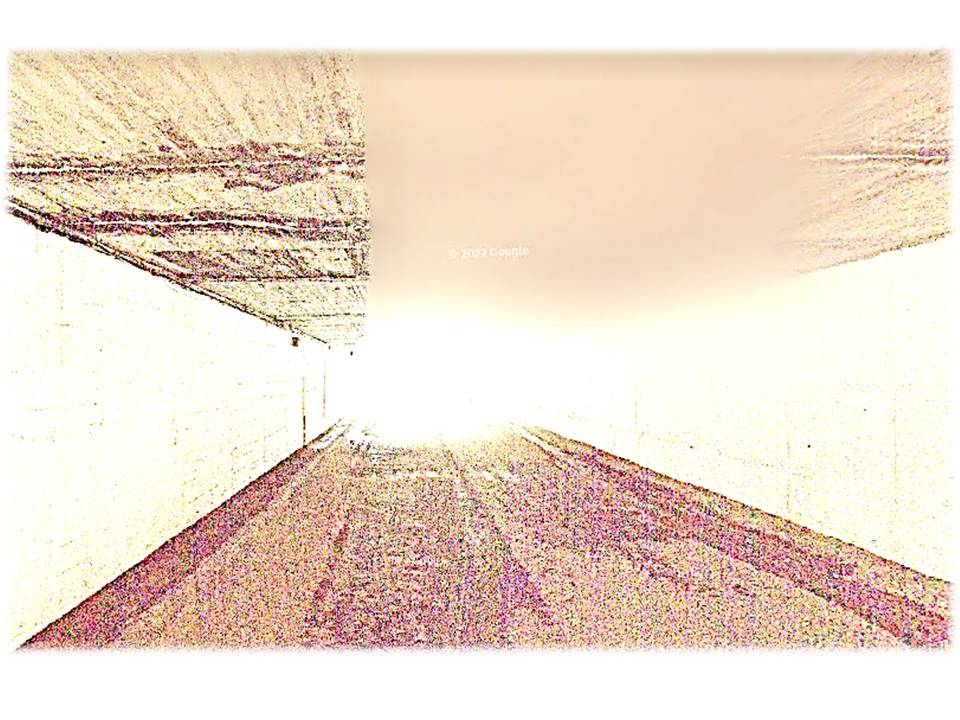
I panic for a second, wondering if this is the famous ‘light at the end of one’s life tunnel’, but I soon calm down to focus on analyzing the reason behind this shift. I have the feeling that I’m experiencing two tunnels at once: the first one in Tabernas, the second in Mondújar, Granada. The latter goes under another highway, the A-44, and it leads to the ruins of Soraya’s castle. Yes, I am sure of it now. I remember this other tunnel from one time I walked through it to climb that castle mound. I visited the castle’s remains with a friend who worships Boabdil.

The castle stands among prickly pears, amidst almond, fig, medlar, olive, orange and pomegranate trees, and above an acequia lined with wild roses and pink dompedros—those flowers I would always misname ‘San Pedro’ before learning their magical ‘official’ name: Mirabilis Jalapa. Magnificent present from Soraya’s Sultan, su rey (her king), the structure is slowly but surely crumbling back into the earth, badly wounded by a victorious cross stabbing the rocky terrain where the stone ship is still anchored, sadly aware of its impending sinking.



Even though the village of Mondújar honors Granada’s Muslim past through street names and signs, it has allowed ‘progress’ to forever desecrate the whole Nasrid lineage, first in the 16th century when Christian newcomers turned the rawda (Muslim cemetery) into cultivated grounds, and then in the 20th and 21st centuries, when ‘authorities’ built the highway on top of the Royal tombs, despite surveying at least 70 of them, bones and all. Talk about spitting on one’s past.
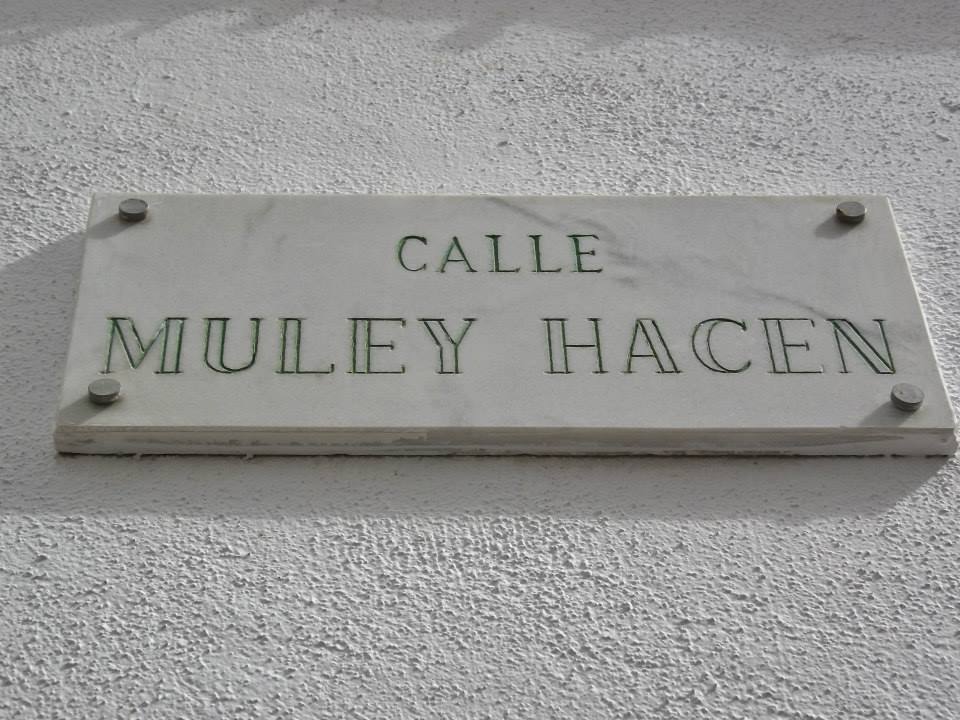
In this other tunnel in Tabernas, I close my eyes, to go back in spirit to my house in front of Granada’s mountain, the majestic Sierra Nevada where legend prefers to have buried Hassan. Immediately after seeing the mountaintop in my mind’s eye, I feel a shift: as we step out of the tunnel, which has regained its corrugated spiral self, the matching jeans and shirts Billy and I sported seconds ago have been covered with Moorish attire. For a second, I feel as though a parallel universe has been created. It is a feeling akin to those strange ‘anomalies’ around which the Mandela Effect has built a reputation. From Mandela to Butterfly, all there is left, once into ‘effect’, is a flutter of eyelashes. Contrary to his doubting habit regarding ‘that turn in Albuquerque’, Bugs Bunny winks at me from the heart of the Looney Tunes/Toons spiral to salute my veering instinct.

I can’t wait to blink ourselves into a new reality, and I’m in for a treat. On this side of the tunnel, nothing is left of the present-day village of Tabernas. All I can see is the castle mound before us, covered with prickly pear cacti. A dirt path leads up to the royal abode magically restored to its ancient glory. Our beautiful attire shines under the generous sunrays. I wear a gold-color veil, and I am in love with my gorgeous red silk kaftan gown, embroidered with red crystal pomegranates and golden roses. With my right index finger, I gently follow the sinuous path of the delicate gold thread. It draws hundreds of petals on the precious fabric that softly cascades down Torda Chica’s shoulder. As the mare starts ascending the slope that leads to the castle, my senses bring a vision of the coming into being of the golden roses of my gown. The genesis of their existence unfolds before my eyes.
Men are digging for gold in the river, whose current name is a Latin reminder of the precious metal it contained: el Darro. A strange certitude tells me that the prospectors’ best chance to find their prized nuggets is to gold pan between two bridges over the water: the first one is the famous broken bridge in front of which I lived, the one I renamed Qantarat al Hurría—Freedom Bridge— in my cat stories. That is the same bridge under which I hid when I started writing this current ‘saga’, and also the very same broken bridge that made its symbolic way inside my ailing knee, which was revealed (and relieved) during a powerful hypnosis session with Ángel the hypnotherapist. Down river, the second bridge, now vanished, used to straddle the still ‘unvaulted’ river at the end of Calle Elvira, the remnant of the North-South axis that led to the heart of the city. I smile as I remember a story my students and I had written in French for my Belgian hometown website. It spoke about friendship, travels, legends and cursed love between different religions; it ended at Calle Elvira, where the ghost of an old man named Hassan gave a blessing to his young Belgian friend Eva, because she had kept her promise to him: to visit Granada on his behalf…
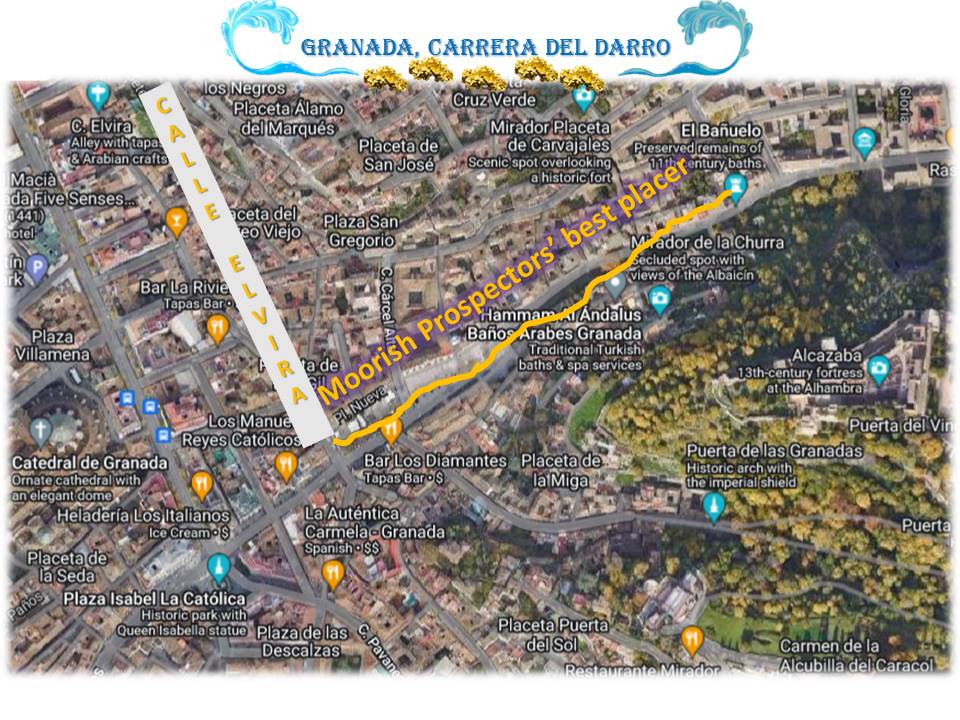
“OUCH!!! My foot!!!!!” shouts Billy, bringing me back to Tabernas through his rough awakening caused by a close encounter with a prickly pear cactus along the dirt path.
“Oops, sorry!” I apologize. “Torda Chica tries her best, but this path is a bit narrow. We’re almost there,” I say in a reassuring voice. “Oh look! How on earth has this black paper rose ‘landed’ on the cactus???” I wonder, retrieving the rose from atop its prickly shrine to keep it in my bag. “Some time ago I made this exact same rose, to adorn a fake book that depicts Última’s healing powers…” I say.
“Oh yeah, that book you carried along when you had a vehicle malfunction on my old stomping grounds near Puerto de Luna…” Billy acquiesces, apparently remembering moments he has witnessed.
“So you were there, ghost-lurking me, when I had that flat tire?” I inquire. “You could have helped, then!” I joke.
“Dunno if I was ‘lurking’ then, but right now I’m looking at myself and I don’t understand what I am wearing at all!” he answers, cleverly dodging my question to focus on the Moorish attire we suddenly sport.
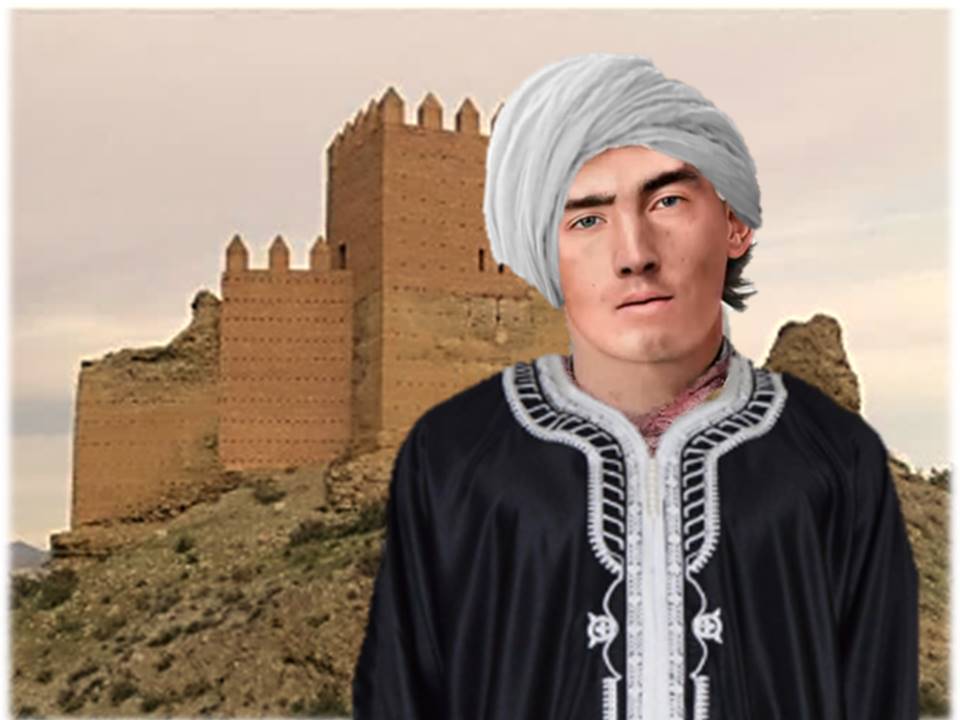
(AI-enhanced Billy tintype by Nic Thamm, Moorish ‘décor’ by Nathalie)
“I guess the magic of the dream realm thought it would be appropriate for you to pay a visit to Soraya in this attire, rather than covered with a bed sheet,” I tease, reminding Billy of a funny expression we discussed earlier on our adventures: ‘the sheeted tenantry,’referring to ghosts.
“Right! Our conversation by the gallows,” remembers the outlaw. “It feels like eons ago!”
“I know! Plus, you’ve been sleeping for a long time,” I add. “Meanwhile I had an interesting spirit talk with Spanish poet Federico García Lorca. He and I healed several wounds we carried. I wonder if sometimes he visited Soraya here…”
“Why are you so sure that this Soraya you keep talking about is here?”
“I just know… Look! There’s the castle gate!” I exclaim, pointing at the pink-tailed cat triumphantly sitting by the castle entrance like a tiny Sphinx.
Billy and I dismount Torda Chica by the gate. As he leads the mare to a nearby alberca (Andalusian Spanish for water tank), I pet the purring cat, thanking him for his guidance, and I approach the entrance: under a beautiful arch decorated with plasterwork vegetation and framed by a multicolor-tile frieze, stands a gorgeous wooden door with carvings very familiar to me.

The door displays two kinds of eight-pointed stars. One—the result of the superposition of two concentric squares— is the Tartessian Star, considered the sun-worshipping emblem of Al-Ándalus since the dawn of time. In another story years ago, I had written about this ubiquitous star in Granada. In that text, my ‘guide to the other side’ was already a cat, who spoke in verses to me, reciting a song by Carlos Cano from his Granada Chronicles: la Casida del Rey Chico. Then I ended up channeling the spirit of Boabdil flowing down the Darro River. The other kind of star carved on the door ‘shoots’ four sets of 2 spikes in the four directions. The spikes resemble capital ‘Ms’, a symbol often associated with Venus, both Star and Mother Goddess. The combination of those two types of stars brings to mind the Statue of Liberty standing on a ‘hybrid’ star shape, which mixes different spike styles in one structure. Some say Lady Liberty does represent Venus too… However, the design of ‘her’ platform is an 11-pointed star.

I have never been too knowledgeable about the Cosmos and its wonders, but these particular stars on the door fascinate me, and I feel the urge to repeat my gesture from a while ago, when I followed the golden thread of roses. I start tracing the contour of ‘Venus’ with my left index finger, and once I complete the whole set of 8 ‘Ms,’ the door slowly creaks open.
Alerted by the sound, Billy, before rushing by my side to enter the castle with me, says in a cute baby talk: “Pinky Cat, sweet fur baby, you will be a good boy and watch over our precious Torda Chica while we’re in, yes?”
The cat arches his back, wraps his tail around Billy’s leg as he rubs his head on his calf, and then obliges with a sweet meow, purring his way to Torda Chica who greets him with a gentle neigh. Billy and I enter the castle’s hall, lined with torches on the walls. I am a bit disappointed to see no exuberant display here. At first sight, the zaguán (hallway) is devoid of any decoration, except for a discreet plasterwork frieze along the walls, which depicts, in its center on both sides, the Nasrid motto inscribed in yet another Tartessian Star.

“Wa la Ghalib ila Allah,” I say, pronouncing the only Arabic inscription I can read.
“Oh lala what?” Billy wonders.
“ILA ALLAH,” I repeat, smiling. “It’s the Nasrid motto. It means, más o menos, ‘Only God [Will Conquer]’…”
“I concur,” jokes Billy.
“God, you crack me up…” I say, looking into Billy’s mischievous eyes under the torches’ flickering light. Then, suddenly astonished by what I see, I add: “Why does it feel like, all of a sudden, your blue eyes are tinting your whole face?”
“Look!” whispers Billy, pointing at the ceiling while placing a hand over the turban he ‘inherited’ from the time tunnel, to prevent it from falling.
All the magnificence I longed for on the walls is concentrated above our heads: the whole dome-shaped surface is colored in a very dark shade of blue, in which a cluster of bright dots appear to twinkle, thanks to the changing reflections of the flames dancing on their torches. There are bigger dots in the center, painted with a mixture of white paint and silver pigment. The ‘dots’ are surrounded by different shades of turquoise blue, to crown each bigger star with a wonderfully vibrant halo.

“Thuraya,” a man’s voice is heard at the end of the hall, “what does she say about being dressed up our way?”
Billy and I cautiously hurry to the door at the end of the hall, where the voice is coming from.
A woman’s voice answers, reading out loud: “I fondly remember the day I had asked my cousin’s sons to choose between two activities: either a burro ride through the Albayzin, the old Moorish neighborhood, or a photo session in Moors’ costumes… Their choice reveals our family’s passion for History and foreign cultures!”
Those words strike me as very familiar, and they automatically conjure up in my mind’s eye pictures of family members and myself during a photo session held eons ago on the hill facing the Alhambra.
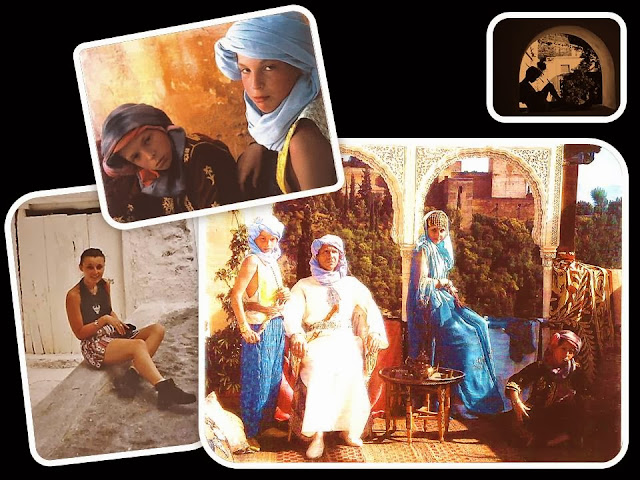
“If you hadn’t told me this image was of XXth-century Christians, I would have sworn it was you with someone impersonating my brother, ukhti! Now the children really look like Nasr and Saad when they were little. They were so fair-skinned…” the man says.
“I know!” agrees the woman’s voice. “But I assure you it’s her, not me… I worked so hard to catch her attention… for many Earth years! So I guess I did influence her somehow. She would somewhat hear but not really listen… Now, alhamdulillah she has finally truly heard the call. We met once, briefly, back at the Alhambra, and she helped liberate my spirit from the loop I was trapped into, so she thought we were done with the work. However she has recently sensed that some things were left undone, and I know she’s coming back to me. Speaking of calling, listen to what comes next in her description: ‘…Our borrowed outfit felt like a treasured item found in an old trunk kept in the attic of our minds, like remnants of the old splendor of the vanished dreamland of Al-Andalus, a nostalgic past that Granada, like few others, still mirrors for its visitors…”
“Soraya is reading from MY text!” I murmur. “I told you she was the one waiting for us, Billy!”
“The man said ‘THuraya’ though,” Billy objects, insisting heavily on the ‘th’ sound, through his funny buck teeth.
“Yes, graTHias, I noticed that,” I tease, still keeping my voice very low. “It’s the correct Arabic pronunciation, but Spaniards transformed it. The man mentioned ‘his brother.’ I think he is… El Zaghal, Soraya’s brother-in-law!!”
Soraya goes on reading through our whispering.
“Al-Andalus is long gone, but its aura still lingers in the air and is yet to be seen in some of the town’s faded marks, like an evanescent henna tattoo, or in the Alhambra’s arabesques, so perfect that only nature’s fairies seem capable of having crafted marble blossoms as delicate as desert roses. I had bought one of those natural marvels near Tangiers, Morocco, in the caves of Hercules, in front of an opening called the Mirror of Africa because its shape looks like the map of Africa seen in mirror. It is situated below Cape Spartel, a cape facing the shores of Europe. Legend has it that Hercules took a nap here after separating Europe from Africa, thus creating the Strait of Gibraltar.”
“Sounds like Hercules takes naps like me, heehee…” Billy reacts.
“Oh my God!” it dawns on me. “This is why Federico and I have mentioned Cape Spartel, and the Pillars of Hercules. The memory of my literary images about that place was preparing me to witness this present moment!”
Soraya is finishing her reading of my text: “it is interesting to see how this rocky window onto Europe is filled with optical illusions. By the way, am I the only one to see a triple sunset on the sea horizon? Maybe what I mistake for two additional suns are Europe’s coastal lights, but I prefer to believe in a Fata Morgana or mirage… which has the same root as “Mirror” and means ‘to look at, to wonder at, to admire.’ The more I look at this opening in the rock, the more I see it as a huge keyhole too.”
“Yes, this is SO mine! I remember how moving it was for me to write this passage, and I literally saw the giant keyhole!” I tell Billy as I place my hand over my heart, overwhelmed with emotion. This is when I feel something I hadn’t yet noticed in my new outfit. I cannot believe what my fingers are touching. I am wearing a very special pendant made of a pearl and a white dove feather.
“LA PERLA DEVUELTA!!!” I exclaim!
“Hush, they will…”
Billy is unable to finish his sentence before the man’s voice ironizes: “Well it sounds like someone is looking through OUR keyhole as we speak, haha!”
“Come on in!!!” says Soraya in a happy tone.
A bit ashamed for eavesdropping on them, Billy and I clear our throats as we push the door open to greet our hosts, starting with me pronouncing “Assalamaleikum” as I extend my right arm in a circular motion, which Billy promptly imitates.
“Aleikumsalam,” both Soraya and her brother-in-law answer in unison. “I am so happy to see you again!” Soraya tells me, hugging me the Moroccan way, which ends with a ‘double kiss’ on one cheek. “And YOU… must be her famous Billy,” she says turning to my companion with a big smile.
Billy awkwardly takes her hand to kiss it but she gently takes it back, teasing him a bit: “I know I am technically your elder in Earth centuries, but please, among ghosts, let us not mark this difference with the hand-kissing thing, will we?”
“Oh! I was just being a gentleman…” Billy protests.
“I know, and I appreciate it. Well, let me introduce you to the other gentleman in the room. Billy, Nathalie, this is my brother-in-law Muhammad, nicknamed al Zaghal, the brave.”
“Nice to meet you,” Billy answers, timidly extending his hand, wondering if there’s another, more proper way to greet men here. He is relieved to see that al Zaghal extends his hand back, after which he places it on his heart, the same gesture which enabled me to feel the necklace that magically made its way to me, therefore triggering the exclamation that revealed our presence.
“Please join us at the table,” invites Soraya. “We were just about to have a cup of delicious Na3na.”
“What is that?” Billy asks me in a very low voice.
“Just mint tea…” I answer in a reassuring tone, while making a mental, bilingual note to self: “Funny how the Arabic, guttural sound in-between the two ‘twin syllables’ turns the Spanish for ‘lullaby’ into soothing tea…”
TO BE CONTINUED


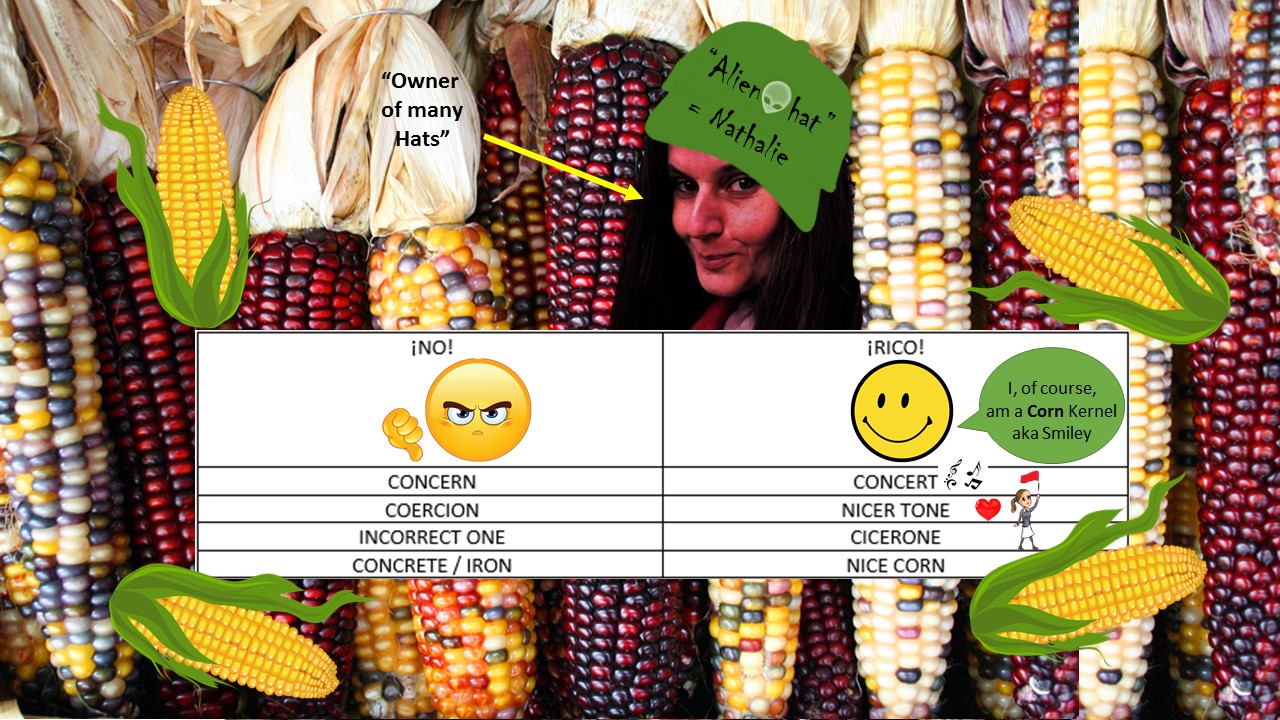
One thought on “The Story of the People’s Tree ~Moorish Detour~”